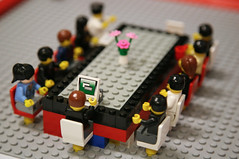Most of the time, the traveling that I do is tedious, stressful, and humiliating (you often feel like cattle being herded into and out of airplanes). But this is a very interesting trip. First, Brenda traveled with me on the first leg, flying up to New York, and then the train to New Haven, Connecticut for a professional development institute in a nearby district. Brenda spent the day bumming around in New Haven, a very pretty and pedestrian town.
 Then we trained back down to New York, where we had dinner with my brother, and “took in a show.” Called “Rock ‘n’ Roll,” it was supposed to have been fun. Instead it was a serious and long play about decedents in Communist Czechoslovakia and loud rock music. We loved it.
Then we trained back down to New York, where we had dinner with my brother, and “took in a show.” Called “Rock ‘n’ Roll,” it was supposed to have been fun. Instead it was a serious and long play about decedents in Communist Czechoslovakia and loud rock music. We loved it.
Brenda and I split at the airport the next morning, and I’m in Denver now, getting ready to do a serious of workshops with JeffCo Schools. I’ve worked for them before, a great bunch of folks, who were very early with tablet PCs. There is excitement here with a district that is oriented to the future and their momentum is building. I’ll be here for two days, which, those of you who do this know, is a luxury. I can actually move in to a hotel room.
Friday night I get to mark off one, from my list of states I’ve not worked in — Alaska. I’m barely there for 24 hours, and most of it will be dark. But I’ll technically be there. In Alaska, I’ll be delivering a keynote for their School Boards Association, which will be a distinct honor. Alaska has a 1:1 program going on — and it was initiated by, promoted, championed, and supported by the School Boards Association. I’ll likely be writing more about my brief experience there.
Finally, there’ll be a long flight to Columbus, Ohio for their Library Media conference, which will be a fabulous way to finish this trip. Fabulous? I guess New York hasn’t worn off yet.
Nothing else new, except that it was refreshing to see a full theater for that play on Tuesday night. It was people, community, coming together to pay attention to real people, in person, practicing their craft. I think that we need this!


 At the Illinois School Library Media Association conference last week, a librarian walked up to me, after the keynote, and asked about online databases. “What’s the future of databases?” “They’re expensive, should we be investing in them?”
At the Illinois School Library Media Association conference last week, a librarian walked up to me, after the keynote, and asked about online databases. “What’s the future of databases?” “They’re expensive, should we be investing in them?” 